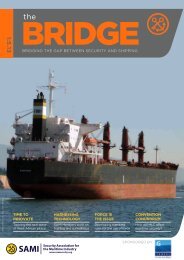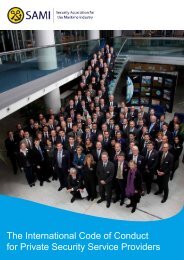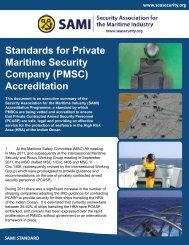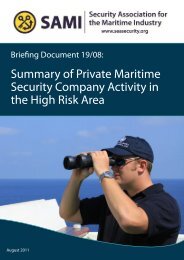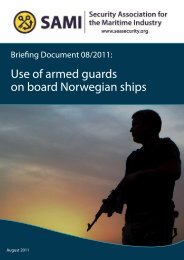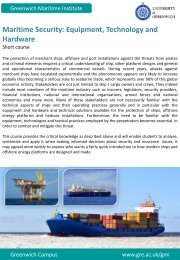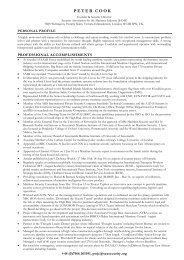C3.1.c. What are “special purpose ships”?Special purpose ships are training or other ships constructed in compliance with theIMO Code of Safety for Special Purpose Ships, 2008, 25 <strong>and</strong> subsequent versions. 26C3.1.d. Must seafarers always be given individual sleeping rooms?Under St<strong>and</strong>ard A3.1, paragraph 9(a) of the MLC, 2006, in ships other than passengerships, an individual sleeping room must be provided for each seafarer; but, in the case ofships of less than 3,000 gross tonnage or special purpose ships [see C3.1.c. What are“special purpose ships”?], exemptions from this requirement may be granted by thecompetent authority [see A25. Who is the competent authority?] after consultation with theshipowners’ <strong>and</strong> seafarers’ organizations concerned.C3.1.e. Does the MLC, 2006 require that cadets have a single cabin?This situation <strong>and</strong> terminology may vary between countries. The following answerassumes that the term “cadet” refers to a young person enrolled in a training programme toobtain specific qualifications, which may require work experience on board. TheMLC, 2006 does not directly address the question of accommodation for cadets as distinctfrom other seafarers. The general rule, <strong>and</strong> the possibility for exemptions, referred to inanswering [see C3.1.d. Must seafarers always be given individual sleeping rooms?] wouldtherefore apply.C3.1.f. Must seafarers have sleeping rooms on board ships engaged on day trips?St<strong>and</strong>ard A3.1, paragraph 9 of the MLC, 2006 sets out the requirements where“sleeping accommodation on board ships is required”. If a ship is not engaged in voyageswhere seafarers would need to sleep on the ship then sleeping rooms would not berequired.C3.1.g. Must each seafarer be provided with private sanitary facilities?St<strong>and</strong>ard A3.1, paragraph 11 of the MLC, 2006 requires ships to have a sufficientnumber of sanitary facilities (with a minimum of one toilet, one wash basin <strong>and</strong> one tub orshower), separate facilities being provided for men <strong>and</strong> women. Each seafarer is to begiven convenient access to them. The <strong>Convention</strong> does not require private sanitaryfacilities for each seafarer, but, as recommended in Guideline B3.1.5, paragraph 2 [seeA12. What is the status of the Guidelines in Part B of the Code?], where the size of theship, the activity in which it is to be engaged <strong>and</strong> its layout make it reasonable <strong>and</strong>practicable, sleeping rooms should be planned <strong>and</strong> equipped with a private bathroom,including a toilet, so as to provide reasonable comfort for the occupants <strong>and</strong> to facilitatetidiness.C3.1.h. Can the floor area of adjacent private or semi-private sanitary facilities be consideredfor purposes of calculating the minimum floor area in sleeping rooms?St<strong>and</strong>ard A3.1 of the MLC, 2006 sets out detailed requirements as to the minimumfloor area of sleeping rooms, but does not specify how these areas are to be measured. Itprovides, however, some guidance (in Guideline B3.1.5, paragraph 6) that space occupied25 IMO. 2008. Code of safety for special purpose ships. Second Edition, 2008 (London, IMO).To be found at: www.chart<strong>and</strong>mapshop.com.au26 To be found at: www.imo.org/publicationsFAQ 29
y berths <strong>and</strong> lockers, chests of drawers <strong>and</strong> seats should be included in the measurementof the floor area, but not small or irregularly shaped spaces “which do not add effectivelyto the space available for free movement <strong>and</strong> cannot be used for installing furniture”. Sincean adjacent partitioned sanitary facility would not add effectively to the space available forfree movement etc., it could be concluded that the existence of private or personal sanitaryfacilities would probably have no impact on the measurement of minimum sleeping roomfloor areas under St<strong>and</strong>ard A3.1, paragraph 9, although they may be relevant to a questionof substantial equivalence [see A11. What is a “substantially equivalent” provision?].Could less space be provided in sleeping accommodation in return for greatercomfort? This question has been raised in the context of ships with limited space forseafarers’ sleeping rooms. It raises the concept of “substantial equivalence” addressed inArticle VI, paragraphs 3 <strong>and</strong> 4 of the MLC, 2006 [see A11. What is a “substantiallyequivalent” provision?]. Any solution to compensate for less floor area in sleepingaccommodation would need to be “conducive to the full achievement of the general object<strong>and</strong> purpose” of the requirements relating to floor space to “give effect to” the provision orprovisions concerned (Article VI, paragraph 4). Such a solution might reasonably consistof extra space such as a big, more comfortable day room to be shared by adjoining sleepingrooms; or the definition in Article VI, paragraph 4 might possibly justify a solutionproviding extra comfort related to sleeping room accommodation, such as the provision ofen-suite sanitary facilities. The question has even been raised as to whether extra comfortin general, unrelated to floor area, could be considered in the evaluation of a substantiallyequivalent solution, such as the grant to the seafarers concerned of extra free time ashore.It is in this context that ratifying members should assess their national provisionsfrom the point of view of substantial equivalence, identifying the general object <strong>and</strong>purpose of the MLC, 2006 Code, Part A provision concerned (in accordance withparagraph 4(a)) <strong>and</strong> determining whether or not the proposed national provision could, ingood faith, be considered as giving effect to the Part A provision (as required byparagraph 4(b)).C3.1.i. Why are frequent inspections of ship accommodation required <strong>and</strong> who is to carrythem out?Under St<strong>and</strong>ard A3.1, paragraph 18 of the MLC, 2006, frequent inspections are to becarried out on board ships, by or under the authority of the master, to ensure that seafareraccommodation is clean, decently habitable <strong>and</strong> maintained in a good state of repair. Theresults of each such inspection must be recorded <strong>and</strong> be available for review. Theseinspections are a key part of ensuring ongoing compliance between flag State inspections.The related procedures are likely to be part of a shipowner’s plans, as set out under Part IIof the ship’s declaration of maritime labour compliance [see C5.1.l. What should becontained in Part II of the declaration of maritime labour compliance (DMLC)?].C3.1.j. Is there any flexibility provided with respect to the requirements for accommodation<strong>and</strong> recreational facilities?The MLC, 2006 contains a significant level of technical guidance with respect tonational implementation of the st<strong>and</strong>ards for on board accommodation <strong>and</strong> recreationalfacilities. These provisions, which are directed to flag States, apply to all ships covered bythe <strong>Convention</strong>. However there also are some exceptions <strong>and</strong> flexibility based on factorssuch as gross tonnage levels as well as specific adjustments for some categories of shipssuch as passenger ships or special purpose ships [see C3.1.c. What are “special purposeships”?], as well as the possibility for small ships, under 200 GT, to be exempted fromcertain requirements, after consultation with the shipowners’ <strong>and</strong> seafarers’ organizationsconcerned.30 FAQ
- Page 8: C5.1. Flag State responsibilities .
- Page 11 and 12: the Convention regarding the need f
- Page 13 and 14: oard ships but are not directly inv
- Page 15 and 16: supervisory system (a system establ
- Page 18 and 19: A16. How does the MLC, 2006 make it
- Page 20 and 21: A19. What will happen to the mariti
- Page 22 and 23: B. Questions about the workers andt
- Page 27 and 28: authority?] as qualified to issue s
- Page 29 and 30: C1.3.b. Does this training requirem
- Page 31 and 32: It may be useful to also consider t
- Page 33 and 34: equirements for upgrading or promot
- Page 35 and 36: C2.3.h. Do the hour of rest and hou
- Page 37: C3. Title 3 Accommodation, recreati
- Page 41 and 42: C4.1.b. Must every ship have a ship
- Page 43 and 44: • the cost of safeguarding the pr
- Page 45 and 46: (b) facilities for sports and outdo
- Page 47 and 48: • Sickness benefit• Unemploymen
- Page 49 and 50: agreed upon international standards
- Page 51 and 52: provisions of Regulation 5.1.3 and
- Page 53 and 54: C5.1.o. What is the period of valid
- Page 55 and 56: (b)(c)to carry out any examination,
- Page 57 and 58: prevents ships being delayed by unn
- Page 59 and 60: certificate and DMLC should be the
- Page 61 and 62: C5.2.q. Are complaints confidential
- Page 64 and 65: INTERNATIONAL LABOUR CONFERENCECont
- Page 66 and 67: Maritime Labour Convention, 2006MAR
- Page 68 and 69: Maritime Labour Convention, 2006(b)
- Page 70 and 71: Maritime Labour Convention, 20062.
- Page 72 and 73: Maritime Labour Convention, 2006Pla
- Page 74: Maritime Labour Convention, 20062.
- Page 78: Explanatory note to the Regulations
- Page 82 and 83: Minimum requirements for seafarers
- Page 84 and 85: Minimum requirements for seafarers
- Page 86 and 87: Minimum requirements for seafarers
- Page 88 and 89:
Minimum requirements for seafarers
- Page 90 and 91:
Conditions of employmentTITLE 2. CO
- Page 92 and 93:
Conditions of employmentGuideline B
- Page 94 and 95:
Conditions of employment3. National
- Page 96 and 97:
Conditions of employment(a) hours o
- Page 98 and 99:
Conditions of employment4. Paragrap
- Page 100 and 101:
Conditions of employmentRegulation
- Page 102 and 103:
Conditions of employment(b) accommo
- Page 104 and 105:
Conditions of employmentciently and
- Page 106 and 107:
Accommodation, recreational facilit
- Page 108 and 109:
Accommodation, recreational facilit
- Page 110 and 111:
Accommodation, recreational facilit
- Page 112 and 113:
Accommodation, recreational facilit
- Page 114 and 115:
Accommodation, recreational facilit
- Page 116 and 117:
Accommodation, recreational facilit
- Page 118 and 119:
Accommodation, recreational facilit
- Page 120 and 121:
Health protection, medical care, we
- Page 122 and 123:
Health protection, medical care, we
- Page 124 and 125:
Health protection, medical care, we
- Page 126 and 127:
Health protection, medical care, we
- Page 128 and 129:
Health protection, medical care, we
- Page 130 and 131:
Health protection, medical care, we
- Page 132 and 133:
Health protection, medical care, we
- Page 134 and 135:
Health protection, medical care, we
- Page 136 and 137:
Health protection, medical care, we
- Page 138 and 139:
TITLE 5. COMPLIANCE AND ENFORCEMENT
- Page 140 and 141:
Compliance and enforcement(a) has t
- Page 142 and 143:
Compliance and enforcement7. Detail
- Page 144 and 145:
Compliance and enforcement14. A cer
- Page 146 and 147:
Compliance and enforcement5. If a M
- Page 148 and 149:
Compliance and enforcement(a) the i
- Page 150 and 151:
Compliance and enforcementGuideline
- Page 152 and 153:
Compliance and enforcement(c)(d)the
- Page 154 and 155:
Compliance and enforcementStandard
- Page 156 and 157:
APPENDIX A5-IThe working and living
- Page 158 and 159:
Appendix A5-IIThis is to certify:1.
- Page 160 and 161:
Appendix A5-IIMaritime Labour Conve
- Page 162 and 163:
Appendix A5-IISignature: ..........
- Page 166 and 167:
Appendix A5-IIThis Certificate is v
- Page 168 and 169:
APPENDIX B5-I - EXAMPLE OF A NATION
- Page 170:
Appendix B5-IDeclaration of Maritim





